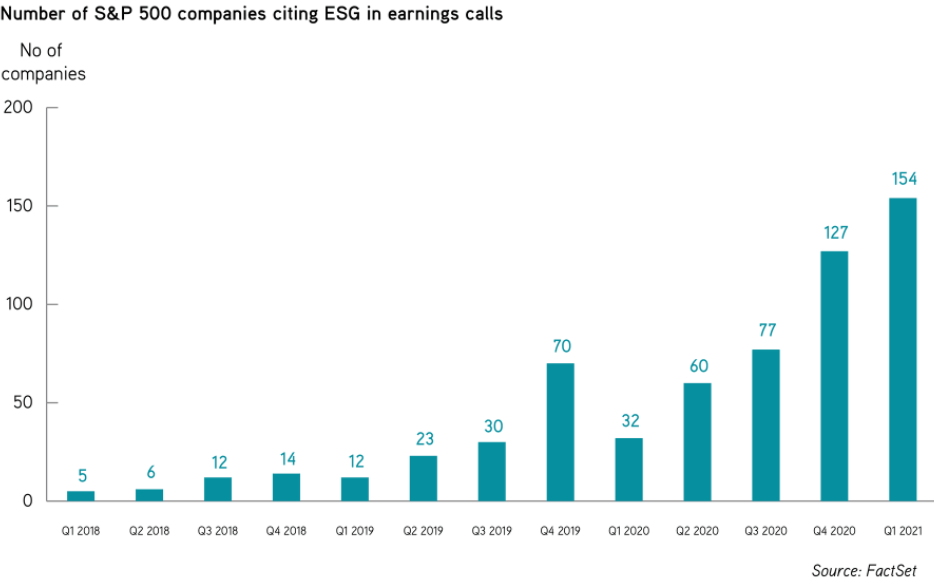Across a series of articles, we look at case studies from investor relations teams that have held an ESG investor day, launched an ESG statbook, discussed ESG on the earnings call and released a thematic report on a single sustainability topic. Are you trying anything else? Get in touch and let us know.
A growing number of companies are discussing ESG issues on the earnings call. According to FactSet, more than 30 percent of S&P 500 companies cited ‘ESG’ during their first-quarter earnings call this year – the highest number on record.
The drivers of this trend are well known: over recent years, investors have increasingly focused on environmental risks, particularly climate change. Then, in 2020, Covid-19 and worldwide anti-racism protests threw an intense spotlight on how companies approach social issues.
But what is the best way to integrate ESG topics into earnings call content? Simply adding some slides at the end of the presentation could indicate ESG is being treated in a superficial way, not as a core risk or driver of value.
‘One of the concerns is the issue of bandwidth,’ says Brian Tomlinson, an adviser to companies on ESG strategy, who co-authored a research report on ESG and the earnings call.
‘We don’t want boilerplate, generic ESG disclosures to take the place of decision-useful financial information. This is about disclosing ESG information that is tailored to the format of the earnings call and its audience, and that supplements and contextualizes the other information that is shared.’

One company that has thought carefully about this subject is Nestlé. In February 2019 CEO Mark Schneider flagged that the global food firm would increase its focus on sustainability issues and creating shared value during earnings calls. ‘We will now make this a more regular feature of our investor calls because I think it is an element that's deeply embedded in our company and sets us apart,’ he said.
Since then, Nestlé has included regular updates on calls. For example, in April 2019 the company included a section on why capsules are actually an environmentally friendly way to consume coffee. The following quarter, Nestlé provided details on how its medical nutrition business is supporting cancer patients.
While many of the updates have focused on specific ESG topics, Nestlé has also used the earnings call to set out its broader approach to sustainability. During the full-year results for 2020, Schneider included several hundred words on why sustainability is key to value creation.
‘It’s important for me that people do not see it only as a short-term impact on our P&L or a burden but, rather, that we see it very much as an opportunity,’ he explained.
‘An opportunity to, first of all, do a great service to society and the Earth around us, but then also a great business opportunity in a world where priorities around sustainability are changing very fast.’
For companies that want to take a more structured approach to including ESG content in their calls, Tomlinson has some suggestions. Companies could spend one call doing a deep dive into ESG issues, and then provide updates on key metrics in the other three quarters, he says.
Alternatively, they could use the CEO’s macro comments once or twice a year to explain how ESG fits into corporate strategy.
‘There are all sorts of ways of doing it,’ Tomlinson points out. ‘This isn’t about completely reimagining the earnings call. It’s about folding in pertinent ESG information.’
This is an extract of an article that was published in the Fall 2021 issue of IR Magazine. Click here to read the full article.










